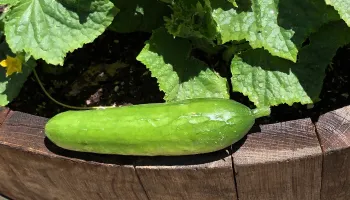Scientific Name
Cucumis sativus
General Information

Warm season crop belonging to the Cucurbitaceae (gourd) family. Produces cylindrical, tapered fruits used as vegetables. Originates from South Asia. Many varieties: slicing, pickling, burpless, seedless, English, Asian and Persian, Armenian and more. Trailing and bush varieties. Choose varieties that meet your site conditions, taste, and that are disease resistant.
When to Plant
Depending on microclimate, direct seed cucumbers from mid-April to mid-June. Plant cucumber seedlings (or starts) as early as April but only if temperatures are 60 degrees or higher. Cucumbers are susceptible to frost and cold damage. Cucumbers do not do well in foggy locations, soggy soils, or windy sites.
Planting
Start seeds indoors beginning in March for transplanting April-June. Seedlings are ready for transplanting in three to four weeks. After hardening-off, be careful to not disturb the roots when planting outside.
Trellising cucumbers from seed: Plant a row of seeds two inches from each side of the trellis. Sow the seeds in pairs, one inch deep, leaving four inches between pairs and thin to the stronger of each pair when the plants are four to six inches tall. Guide the tips through the trellis wire as they grow.
Do not use a trellis. Use straw mulch under the vines to keep the cucumbers off the ground. Guide the vines in the direction you want them to go.
Soil Requirements
Plant in organic, nitrogen-rich, well-drained soil that is kept constantly moist but not soggy.
Water Requirements
Water regularly to keep soil constantly moist, focusing on the base of the plant while keeping the leaves dry.
Fertilizing
Mix a compost soil blend and or aged manure into the soil at planting or initially fertilize with a low-nitrogen, high-potassium/phosphorus mixture. During production, fertilize with a more balanced mixture.
Pollination
Pollinated by bees moving pollen from male flowers to female flowers on the plant (depending on the variety). You can also pollinate by hand if needed. See more on fruit set problems.).
Harvesting
Harvest cucumbers when they are generally one to one and a half inches in diameter (six to seven inches long) for slicing cucumbers and two to five inches long for pickling. Pick every one to two days, as plants will stop or slow production if older, yellowing fruits stay on the vine.
Storage
Eat fresh, store in a plastic bag in the refrigerator for three to five days, or pickle.
Good Varieties for Marin
Slicing:
- ‘Dasher 11’
- ‘Marketmore’
- ‘Sweet Success’
- ‘Burpless hybrid’
- ‘Sweet Slice’
Pickling:
- ‘Liberty Hybrid’
- ‘Saladin’
- ‘County Fair 83’
Bush:
- ‘Pickle Bush’
- ‘Bush Champion’
- ‘Salad Bush’
- ‘Spacemaster’
(all suitable for containers)
Helpful Tips
Consider trellising for straighter cucumbers and to save space. Protect plants from the wind. Mulching will help reduce pests and retain moisture.
Common Problems
Some cucumbers become bitter, especially at the stem end. Mitigate bitterness with good cultivation practices, like growing in full sun and providing regular, consistent water. Root rot and powdery mildew are common problems.
Pests- Diseases & More
Keep an eye-out for cucumber beetles, snails, and slugs. Remove these by hand and destroy. Remove any plants infected with cucumber mosaic virus, beet curly top virus, and zucchini yellow mosaic virus. Plant disease resistant varieties.
